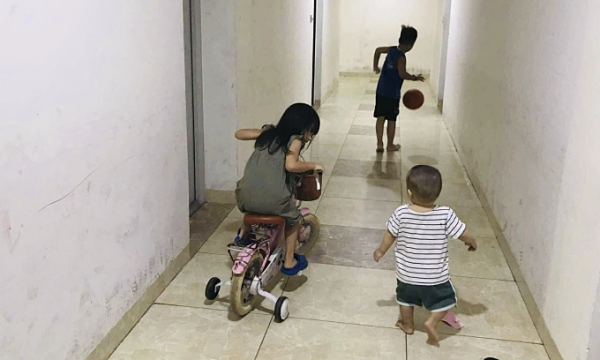
When she lived in her old apartment, Hoang Duyen of Hanoi’s Hoang Mai Ward used to be constantly startled by shouting and thumping balls outside her door at 9 p.m. after a long day of work. And, her four-month-old son would cry in her arms.
“Every evening it was the same,” a weary Duyen recalls. “The neighbors’ kids gathered in the hallway to play soccer and shout. Sometimes even their parents joined in.”
It was not a couple of neighboring children; it involved dozens of kids turning the shared hallway into a cacophonous playground. The screech of rollerblades and clattering of toy cars could continue for hours, making rest impossible.
For complaining, Duyen did only not get any relief but was also often rebuked for being “difficult.” Some claimed that the hallway was a shared space and no one could stop children from playing. Management exhortations would calm things for only a few days.
Unable to put up with it any longer, Duyen eventually sold her apartment and moved to a lower floor with fewer children for peace and quiet.
|
Children play in the hallway of Hanh’s apartment complex in Dong Anh, Hanoi, on Sept. 17, 2025. Photo courtesy of Hanh. |
A Read survey found over 80% of readers being hassled by children playing in apartment hallways. A 2020 study on Hanoi apartment life, published by the U.S. National Library of Medicinefound that 28.3% of families frequently used circulation areas—corridors, elevators, lobbies, main entrances, and halls—for long conversations, and 28.2% accompanied their children to play in these areas.
Frequent use of these spaces can cause discomfort and reduce privacy for neighbors.
For 70-year-old Nguyen Thi Trinh in Dong Anh Commune, hallway noise has become a constant torment. Last year an apartment next to hers was rented out to a daycare center, and since then cries and fussing dominate daytime hours, while neighbors’ children take over at night, running, jumping and banging on doors. “I was exhausted, having to knock on doors to ask for quiet,” she says.
She reported the issue to management and even filed a complaint with local authorities, but to no avail.
The conflict stems from two legitimate but competing needs: children’s right to play and residents’ desire for quiet.
Architect and urbanist Vo Trong Nghia of the University of Social Sciences and Humanities in Ho Chi Minh City says hallways and lobbies are designed for circulation, brief interaction and short-term activities and not meant to be playgrounds. “Children running, playing ball or riding bikes in lobbies can damage shared property and even trigger fire alarms.”
But many apartment complexes lack playgrounds stipulated by the 2014 Housing Law while others have small, unsafe or merely symbolic ones.
Hong Huong of the Vietnam Association for the Protection of Child Rights says children play in hallways partly out of convenience. “It’s instinctive and part of their right to play” but it sometimes conflicts with people’s need for peace and quiet.
Ho Thi Hanh, 32, a mother of three young children living near Trinh in Dong Anh, is regretful that her children’s noise disturbed neighbors. She says that although her apartment complex has a playground, she cannot always supervise all three children, so she does not bring them there often. “Even if we tell them, the kids don’t always listen, especially when neighbors’ children are playing too.”
She adds that most families in the complex have children, and so it is difficult to avoid noise and shouting.
Psychologists emphasize that the responsibility lies with adults. Parents, residents and management need to establish rules, teaching children that play must respect the community, they say.
Under Vietnamese law, excessive noise can attract fines of VND 1-160 million (US$38–$6,060), depending, but enforcement is difficult due to challenges in measuring and analyzing sound, including baseline noise from traffic and other sources.
Security personnel in Trinh’s complex say there are indeed frequent complaints about children’s noise but say enforcement is difficult. “We can only remind parents,” one says.
Nghia recommends structural solutions like separating community spaces with soundproofing or dedicated outdoor playgrounds. Lobby design should use materials that limit noise, and spaces should be clearly divided into waiting, play and circulation areas, he says.
Soft measures like small play corners, partitions and limiting play hours can also help, he says.
Globally, there are three common approaches to address hallway noise in apartment buildings: having soundproof indoor play areas, small outdoor play spaces on the ground floor or rooftops utilizing leftover areas and clearly separating lobbies, waiting areas and play zones.
Ultimately, Nghia says, developers must plan sufficient playground and communal spaces right from the design stage.
“This is the fundamental solution to prevent children from playing in hallways and ensure harmonious living for all residents.”
For Trinh, the only option is to endure the noise until the children grow older and spend more time studying indoors. “But I may not even be around to see it.”